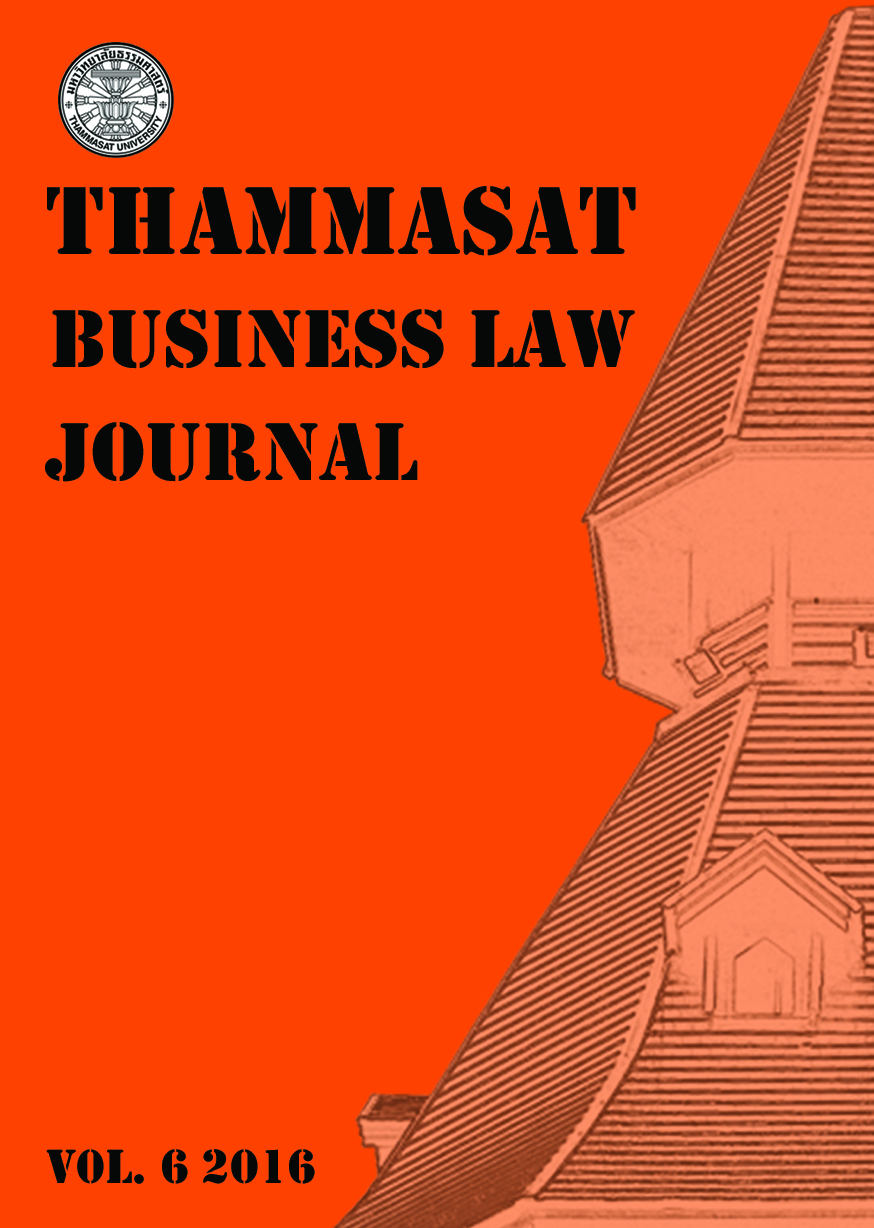REPORTING AND DISCLOSING THE POLLUTION INFORMATION UNDER THE FACTORY ACT B.E. 2535
Main Article Content
Abstract
The objective of this thesis is to study the issue of the reporting and disclosing of pollution information and related problems. In particular, this thesis will focus on comparing Thailand’s existing laws with the concepts and legal controls of reporting and disclosing pollution information under United States law and Japanese law. An investigation is also conducted into the problems and hindrances relating to the enforcement of these laws. This includes looking at ways to improve the requirements of the law for reporting and disclosing pollution information so that better prevention and problem-solving can be effectively implemented.
The study found that the industrial factory sector is governed by the Factory Act B.E. 2535 (1992) which is the relevant law to enforce the reporting of pollution information. However, this law does not effectively allow for prevention and problem solving. This could be a result of the restrictions of the scope of the law and the lack of sanctions found in it. Another issue is that the existing laws only enforce the reporting of pollutants that are released into the air and water. The reporting of pollutants released into the soil is done according to the Ministerial Regulation of Controlling on Soil and Groundwater Contamination Criteria within Factory Act B.E. 2559 (2016). This was recently been enacted on April 29, 2016 by the virtue of the provisions in Section 6 Paragraph 1 and Section 8 (4) - (8) of Factory Act B.E. 2535 (1992). However, this regulation stipulates only that industrial factories must report information of soil and groundwater contamination criteria within the factory area, not outside the factory area. Additionally, on disclosing pollution information, there are no laws under Factory Act B.E. 2535 (1992) to disclose pollution information to the public. There is only the Official Information Act B.E. 2540 (1997) which requires that the government agencies disclose information to the public. However, disclosing or accessing such information is limited to information that is in the possession of the government agency or state enterprises. This does not include the information that is in the possession of factories in the private sector. This is a big problem because people need to access this information in order to protect themselves from the dangers of pollutants.
Therefore, this thesis will amend Ministerial Regulation of Controlling on Soil and Groundwater Contamination Criteria within Factory B.E. 2559 (2016) which is the subordinate legislation of Factory Act B.E. 2535 (1992) to enforce that industrial factory reports the pollution information which is contaminated into the soil and groundwater within factory area, and covering outside factory area. Moreover, it should enact a new subsection of Section 8 of Factory Act B.E. 2535 (1992) to directly force industrial factories in the private sector to disclose their pollution information to the public or give the public the right to access the environmental information and pollution information of the industrial factory.
Article Details
References
วราภรณ์ จานโอ. “ปัญหามาตรการทางกฎหมายเกี่ยวกับมลพิษทางดินจากภาคอุตสาหกรรม”. วิทยานิพนธ์นิติศาสตร์มหาบัณฑิต คณะนิติศาสตร์ มหาวิทยาลัยธรรมศาสตร์, 2554 (Waraporn Janoh. “Problems on Legal Measure relating to Soil Pollution arising from Industrial Sector”. Master of Laws Thesis, Faculty of Laws, Thammasat University, 2011).
อัชฌา สงฆ์เจริญ. “สิทธิในการเข้าถึงข้อมูลสิ่งแวดล้อมในความครอบครองของเอกชน”. วิทยานิพนธ์นิติศาสตร์มหาบัณฑิตคณะนิติศาสตร์ มหาวิทยาลัยธรรมศาสตร์, 2557 (Atcha Songjaroen. “Right of Access to Environmental Information Held by Private Sector”. Master of Laws Thesis, Faculty of Laws, Thammasat University, 2014).
ChemSafetyPro, “PRTR Law in Japan”, http://www.chemsafetypro.com/Topics/Japan/ Japan _PRTR_Law.html
Environment Economic and Policy Studies, “First inventory of pollutant release and transfer register in Japan”, http://link.springer.com/article/10.1007% 2FBF0 3353931#page-2
Ministry of the Environment Government of Japan, “Background to JapanesePRTR”, https://www.env.go.jp/en/chemi/prtr/about/index.html
Ministry of the Environment Government of Japan, “Overview of the PRTR system”, https://www.env.go.jp/en/chemi/prtr/about/overview.html
Ministry of Economic, Trade, and Industry, “Outline of the PRTR system”, http://www.meti.go.jp/policy/chemical_management/english/files/PRTRsystem.pdf
PRTR, “Advantage of PRTR”, http://prtr.pcd.go.th/inner_3.html
กรมโรงงานอุตสาหกรรม, “คู่มือการใช้งานแบบรายงานชนิดและปริมาณสารมลพิษที่ระบายออกจากโรงงาน (รว.1, รว.2, รว.3, รว.3/1 สำหรับผู้ประกอบกิจการโรงงาน)”, http://hawk.diw.go.th/eis/manual-user.pdf Department of Industrial Works, “Manual of using type and quality of pollutants discharged from the industrial factory (RoWo.1, RoWo.2, RoWo.3, RoWo.3/1 for the factory operator)”
โครงการขับเคลื่อนสู่การพัฒนากฎหมายการรายงานข้อมูลการปล่อยมลพิษและการเผยแพร่ข้อมูลสู่สาธารณชน “Toxic Release Inventory : ระบบ PRTR ของสหรัฐอเมริกา”, http://www.learnprtr.net/index.php?lay= show&ac=article&Id= 539650144&Ntype=11 Project Development in the legal of reporting and disclosing the pollution information to the public, “Toxic Release Inventory : PRTR system in U.S.A”
โครงการขับเคลื่อนสู่การพัมนากฎหมายการรายงานข้อมูลการปล่อยมลพิษและการเผยแพร่ข้อมูลสู่สาธารณะ “ประโยชน์ของการรายงานข้อมูลการปล่อยและการเคลื่อนย้ายสารมลพิษ”, http://www.learnprtr.net/index.php?lay=show&ac =article&Id=539649252&Ntype=9 Project Development in the legal of reporting and disclosing the pollution information to the public, “Advantages of reporting PRTR”
โครงการขับเคลื่อนสู่การพัฒนากฎหมายการรายงานข้อมูลการปล่อยมลพิษและการเผยแพร่ข้อมูลสู่สาธารณชน “ระบบ PRTR ของประเทศญี่ปุ่น”, http://www.learnprtr.net/index.php?lay=show&ac=article&Id=539650355& Ntype=18 Project Development in the legal of reporting and disclosing the pollution information to the public, “PRTR system in Japan”
คณะทำงานพัฒนาคู่มือการประเมินการปลดปล่อยและเคลื่อนย้ายมลพิษ จากโรงงานอุตสาหกรรมเคมีและปิโตรเคม, “คู่มือการประเมินการปลดปล่อยและเคลื่อนย้ายมลพิษสำหรับโรงงานอุตสาหกรรมเคมีและปิโตรเคมีในประเทศไทย”, http://www2.diw.go.th/env/admin/Chem-Petrochem.pdf Developing Team of Manual of PRTR Assessment for Chemical and Petrochemical Industrial in Thailand, “Manual of PRTR Assessment for Chemical and Petrochemical Industrial in Thailand”
วารสารการจัดการสิ่งแวดล้อม, “PRTR: อีกหนึ่งเครื่องมือในการจัดการและควบคุมปัญหามลพิษ”, file:///C:/Users/sony/ Downloads/26420-58327-1-SM.pdf Journal of Environmental Management, “PRTR: Measures of Management and Control Pollution Problems”


